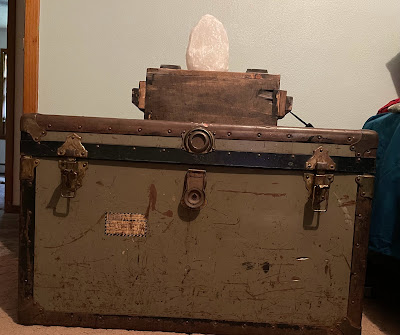July 24, 2022 Something passed down or been around for generations
The Trunk
By: Carrie Keiser
The old trunk had been in the corner of her grandmother’s front room for as long as she could remember. Last week, she watched as her parents loaded it up after Gramms had passed away. It now resided in the upstairs bedroom of their house. Janie sat there staring at the big old thing, she had often looked at it and dreamed of the places it might have gone. She asked Gramms about if a few times and she hadn’t been very forthcoming. Gramms said that it had been her great-grandmother’s and that it had made the trip across the ocean when her their family had left the old country. She never opened it but had always wanted to know what was in it and if it could talk what stories would it tell her? Her mom said it would make a great end table for the guest room and she could store blankets in it. That sounded like a boring story for such a cool trunk to tell.
Janie leaned back and closed her eyes, she pretended she was her 4th great-grandma, Aveline, and she was about to board a ship to a new world. Janie wasn’t sure how old Gramma Aveline was when they immigrated to America, but in her daydream, she was the ripe ole age of 13, same age as Janie was right now. She imagined Aveline packing the trunk full of all her favorite things: a beloved book, the stuffed toy she kept hidden under her pillow, all her comfy clothes (did they have comfy clothes back then? Janie wasn’t sure.) Maybe the whole family had to pack in just one trunk. That would sure change what she got to include. Janie couldn’t recall how many siblings her Gramms’s great grandmother had. She made a family tree last year at school, but the details have now escaped her. Janie thought about what she would put in the trunk if she had to share the space with her parents and two younger brothers. The smile fell from her face as she realized it would be very little that she could bring. If everything you could bring was in the trunk, did that mean the trunk was right there with you in the room? Yes probably. She wondered did the whole family share a room or were they separated by girls and boys? If that were the case then there would have been two trunks. There was so much to consider. She wondered if Aveline was sad to leave her home or excited to see new things.
She came to with a start as she heard her mothers voice calling for her telling her to set the table for dinner. Janie must have nodded off while dreaming about the old trunk and it’s unknown adventures.
Janie’s head was still a little fuzzy from the unplanned nap, but as she stood up something about the room didn’t seem quite right, and there was a briny smell she had never noticed before….
The Writing Desk of Cornelia Jones Vance
Flynn Family Story Slingers
24 July 2022
by Cary Holmquist
Back in the late 1920s or early 1930s, my great-grandmother Cornelia Jones Vance bought an upright writing desk at a farm auction in central Montana. It was likely a “selling out” auction, which is what they called it when a family was giving up farming and moving to someplace less desperate than the downward-spiraling of drought combined with the Great Depression.
I have seen in furniture magazines that this type of desk is called a secretary. On the right side the desk has a small fold down table which can be used as the writing surface about 18 inches or so square. In the case on the right side, above the writing table, is a set of narrow pidgeonholes and a center, small drawer. Below the desk is an open-shelf cubby under a wide drawer that might old a sheaf of paper and such.
On the left side is a narrow lockable, glass-front case of four shelves.
Above the desk and glass case is a shelf area that runs the entire width of the secretary, which came with one long shelf board. A long brass rod across the top supported small brass wrings from which to hang a short curtain or set of curtains.
All of the shelves were adjustable, with a series of peg holes deprived into the narrow walls and small round oak pegs that fit in the the holes to hold up the shelves.
When folded up, the desk has a carved diamond-shaped motif and ahandle lock on the reverse side.
The original oak wood that composed the desk had been stained oxblood (a very dark red color), which was a popular decor device of that time, said to imitate the much preferred or more stylish mahogany, or so I have been told.
Back in the mid-1970s, my Aunt Alta was visiting my grandparents for a few weeks and that was where the desk was temporarily residing and she decided to refinish the desk. So Alta stripped the oxblood finish off of the larger surface areas, but she did not complete the job. Since then I have not known how to restore the antique staining and so the writing desk remains an awkward two-toned oxblood and muddy dark oak. It also has a foot that needs to be restored as it began splitting apart. Other than that, it is in good shape and the antique locks for the desk top and glass-door case still work.
My possession of this antique comes through a hand-me-down history like this:
My mother Coreen Vance lived with her Grandmother Cornelia for the first six years of her life and was called by most of the extended family as “Grandma Vance’s pet.” She had this family-joke nickname only because Coreen went wherever her grandmother went, and also because Grandma Vance was a sturdy pioneer kind of woman who had borne children on actual wagon-train migrations. At her house, Grandma Vance had no patience for animal pets—all animals had to work hard for their keep—like herd dogs or horses or mules—or they were raised as food—like chickens or goats or pigs and sheep. No pets as such. But a little girl who tagged around like a little dog, she was the closest Grandma came to having a pet.
Anyway, when Granda Vance died in 1950, her modest belongings were given away to family members and then-teenage Coreen claimed the writing desk as her inheritance. So it moved from Bynum, Montana, to rural northwest Cascade County and was stored on an old house at her parents’ farm home while Coreen finished high school and college.
When Coreen moved with her own family of five circus-monkey kids moved back to a neighboring farm, she moved the writing desk to her home and it was installed in my bedroom, which was the largest bedroom in the house and I shared with my two younger brothers.
I pretty much adopted the desk as my own and promptly stuffed the shelves with all kids of books I had acquired and various knickknacks that I accumulated, such as a souvenir harmonica to a bat fossil I found on a Boy Scout hike, to blown-glass animals from the State Fair in Great Falls.
Later, after finishing college, I took over custody of the writing desk. Because the desk is unsteady from the splitting foot and its rather unsightly uneven finish, we have kept the desk in our bedroom where it serves as a book shelf and room divider. Our children have rarely seen it, since the back of the desk, at about five-feet-six high, just looks like a wall inside the door of our bedroom.
Nonetheless, Grandma Vance’s writing desk is a treasure to me, full of childhood memories and as my only inheritance from a great-grandparent.
###
By: Colleen Holmquist
In the beginning—nigh onto forty years ago—it was a countertop—or part of one—in the new house. But, the counter just took up space, so my dad deconstructed it and transformed it into a simple desk complete with a small drawer perfect for keeping writing supplies. He painted it yellow; I don’t know why.
It was a fixture in bedrooms while my kids were kids. Then “the little girls” aka Tabor Tots— used when they came to visit as a coloring table. It was a bit tall for that so my dad shortened it. We took it out to the patio and used it for a table at family barbecues. During winter it rested in the shed.
I dug it out this summer and now it’s a desk again residing on our recently excavated front porch. I painted it “universal khaki” to match the trim on the house. The drawer holds pens, pencils, an eraser, a clay mosquito repellent coil burner, a broken mini lantern, a lighter, Wanderings by Chaim Potok and some sheets for recording thoughts about scripture references to the Savior. It’s a little short but suits me just fine. I watch the colors of the sky change as the sun slips behind the mountains and listen to the neighbor’s sprinklers and the train whistles and screechy brakes.







Comments
Post a Comment